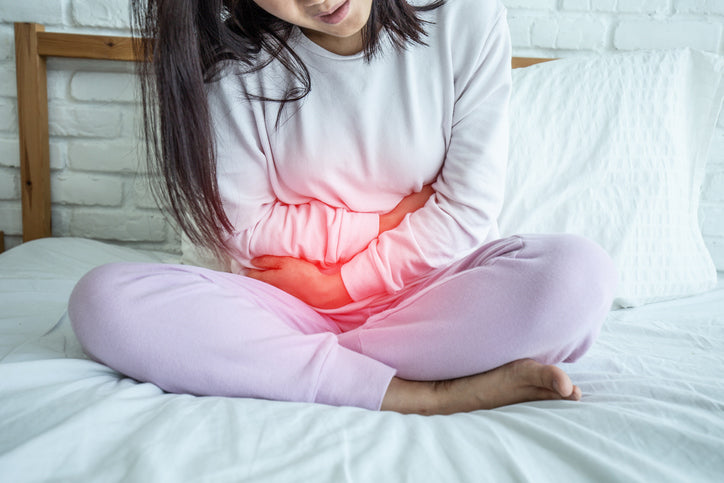If you suffer from endometriosis, you know what it’s like to live with periods so painful that they keep you curled up in bed… unable to live your life the way you want.
This nearly unbearable condition makes it impossible to function at work or school, and can severely affect your quality of life.
Along with the crippling pain, endometriosis can take a huge emotional toll. You may live with anxiety, frustration, or embarrassment surrounding your condition.
And if you haven’t been properly diagnosed – as many women haven’t – you may also have to deal with people in your life that think you’re exaggerating your symptoms.
Endometriosis is real, unfortunately common, and horrendously under-diagnosed.
But regardless of whether or not you have an official diagnosis, it can seem like there’s no way out of the struggle and excruciating pain… but that may be about to change…
Because there are some simple and impactful things you can do to minimize your symptoms… get some real relief… and take back your life...
A Closer Look at Endometriosis
When you have endometriosis, tissue that should develop as the inner lining of your uterus grows in other parts of your body where it’s not supposed to be. This tissue can show up on the outside of your uterus, on your ovaries, in your fallopian tubes, even on your bladder.
And because this tissue *acts* like your uterine lining, every time you get your period this extra tissue thickens, breaks down, and sheds. The problem is that unlike the actual lining of your uterus, this tissue has nowhere to go… so it gets stuck.
The excess and immovable tissue can cause a lot of problems, including:
- Inflammation in your pelvic and abdominal region
- Irritation of surrounding healthy tissue
- Build up of scar tissue
- Ovarian cysts called endometriomas
- Sticky bands of tissue that can make other tissues get “glued” together
- Infertility
Over time, these issues cause increasing damage and become much harder to treat. And the health challenges they cause – including intense pain and cramping, excessive bleeding, and GI symptoms like diarrhea – get more severe and debilitating.
That’s why it’s crucial to get a correct diagnosis as early as possible…
And to start taking steps immediately to address two main factors that drive endometriosis: inflammation and estrogen.

The Connection Between Endometriosis Symptoms and Your Gut
Even though endometriosis counts as a gynecological condition, it has strong connections to your gut microbiome – the trillions of bacteria in your gut.
In a healthy gut microbiome, beneficial probiotic bacteria vastly outnumber harmful pathogenic bacteria. Those probiotic bacteria support wellness and vitality in dozens of crucial ways, like keeping estrogen at healthy levels and ensuring your inflammatory response is healthy and controlled.
But when your gut microbiome is out of balance – a condition called dysbiosis – there’s an overgrowth of pathogenic bacteria.
And those harmful bacteria can cause a lot of health problems, and that includes playing a part in the development and progression of endometriosis.
New research shows that for women with endometriosis, there’s almost always dysbiosis present. Researchers found that the participants’ microbiomes contained specific nasty pathogenic bacteria families, including Streptococcus and Escherichia.
And to top it off, worse dysbiosis was directly connected to stage 3 and 4 endometriosis, more severe forms of the disease!
3 Ways An Unhealthy Gut Causes Endometriosis Flare-ups
When your gut microbiome is out of balance, damaging pathogens run wild and create a state that leads to endometriosis symptoms flare-ups and disease progression. (link: https://pubmed.ncbi.nlm.nih.gov/28778332/)
Here are three key ways that dysbiosis can make endometriosis worse:
1. Pathogenic bacteria release toxins called lipopolysaccharides – also called LPS toxins – that trigger pelvic inflammation and endometriosis growth.
2. Dysbiosis causes damage to the protective gut barrier and sets off leaky gut, which allows LPS toxins and other harmful particles to escape from your intestines into other parts of your body… including the area around your uterus.
3. Gut dysbiosis leads to higher levels of estrogen in your system because pathogens produce too much of an enzyme (beta-glucuronidase) that breaks down the estrogen your body is trying to get rid of and sends it back into circulation.
Your gut microbiome directly affects both inflammation and estrogen levels, the two big factors involved in endometriosis.
Fortunately, you can take proactive steps TODAY to rebalance your gut microbiome and reclaim your gut health… and that can help enormously when it comes to pain caused by endometriosis.

3 Steps to Soothe Your System by Rebalancing Your Gut Microbiome
When dysbiosis rules your gut microbiome, you need to take decisive action to give beneficial bacteria a fighting chance. That involves three important steps:
1. Repopulate your gut with high quality spore probiotics. To restore healthy balance, you need to get rid of pathogenic bacteria and create a positive environment where many diverse strains of beneficial bacteria can survive and flourish. That’s the exact job of spore probiotics such as:
- Bacillus subtilis HU58
- Bacillus indicus HU36
- Bacillus clausii
- Bacillus coagulans
These specific strains have been clinically studied and shown to support healthy balance in the gut microbiome.
2. Selectively nourish only probiotic bacteria with precision prebiotics, a special kind of dietary fiber. Beneficial bacteria feed on these targeted and intelligent prebiotics and convert them into essential short chain fatty acids (SCFAs) – like butyrate – that your body needs to mount a healthy inflammatory response.
The problem with most prebiotic options is that they feed both the good and the bad bacteria in your gut. When you’re trying to rebalance your microbial population, you want to ensure you’re ONLY feeding the beneficial bacteria.
3. Protect and strengthen your gut barrier to keep toxins and other harmful particles locked safely inside. Many people are surprised to discover that our gut barrier gets its powers from our mucosal system. For repair, fortification, and maintenance, your body needs a plentiful mucosa supply – especially if it’s been dealing with attacks from pathogens in the gut microbiome.
By sending in a steady supply of spore probiotics, nourishing beneficial bacteria with prebiotics, and protecting your gut barrier with mucosal support, you’ll be able to keep your gut microbiome healthy and balanced.
Keep Your Gut Healthy with Just Thrive
To feel your best from head to toe, you need a healthy, well-balanced gut microbiome and a strong resilient gut barrier. With Just Thrive, you can confidently support your gut microbiome and your gut barrier for lasting, robust health.
- Our Probiotic introduces a steady supply of beneficial bacteria where they’re needed most, ready to support a diverse population of beneficial bacteria
- Our Precision Prebiotic is intelligently designed to selectively feed ONLY the beneficial bacteria so they can grow and flourish
- Gut-4tify, our mucosal supplement, has been proven to drive the protection and strength of your gut barrier
Deliver fresh support to your gut every day with Just Thrive.









